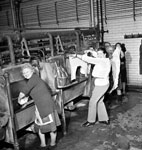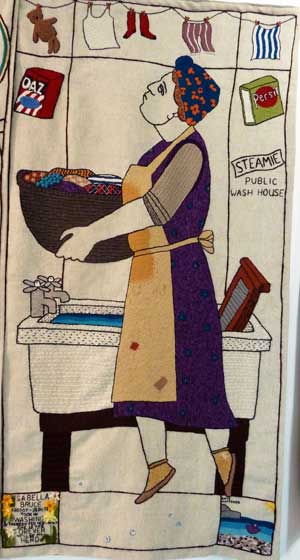Women against Washhouse Closures
Campaign to keep washhouses open as places do the washing and for social interaction and support
As part of the drive against diseases and high infant mortality, public washhouses were introduced to densely-populated urban areas of Britain in the late 19th century, providing facilities for the working classes to wash their clothes and bedding in an effective and affordable manner. The first in Edinburgh opened in 1892. By 1934 there were 13 across the city. Glasgow women coined the term steamie but in Edinburgh washhoose persisted for some years. It was hard work pushing a pram or go-kart laden with washing there and back, scrubbing, transferring sodden washing between sinks and the various tubs, wringing out with mangles before the advent of spin-driers, and finally being blasted by the hot air from the pull-out rail dryers. But for the women the washhouse offered an economical, effective and efficient means of doing the weekly wash and an opportunity to develop their own informal support network through chatting and light-hearted banter.
By the end of the 1950’s with the rise of domestic washing machines and commercial launderettes, housing redevelopments and population movements, the washhouses across the city were running at significant loss and in need of refurbishment. Edinburgh Council introduced plans to begin closures. There was outcry among the housewives. The first major protest was staged in 1962 with a 400-strong petition resulting in the reversal of a decision to close Lochrin and McLeod Street facilities. For the next twenty years when closures were announced the women rallied themselves into protest groups, organised public meetings, wrote letters, staged placard-carrying demonstrations, lobbied councillors and presented deputations at Council Meetings. In 1969 and again in 1971 their protests led to the rejection of a proposal to close nine out of the ten remaining washhouses. Significant closures did not take place until 1977 when only three remained and these finally closed in 1982.The housewives campaign to Save our Steamies was one of the longest running, combative and persistent of its day, with the notable figure of Mrs Mary Logan of Dalry being dubbed Queen of the Steamies.
Helen Harris
Sources:
Robb, Steven. The Public Washhouses of Edinburgh. Book of the Old Edinburgh Club vol. 10 (2014)
Edinburgh Evening News , 2 th and 29th October, 1981
Washhouses: online searches
Scran (www.scran.co.uk) – various illustrations


.jpg)
